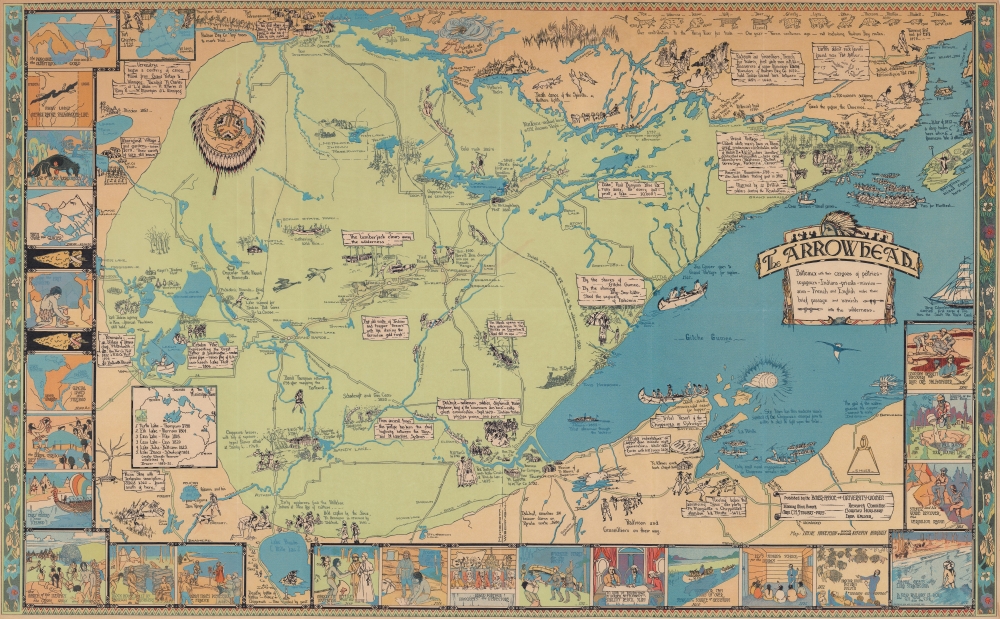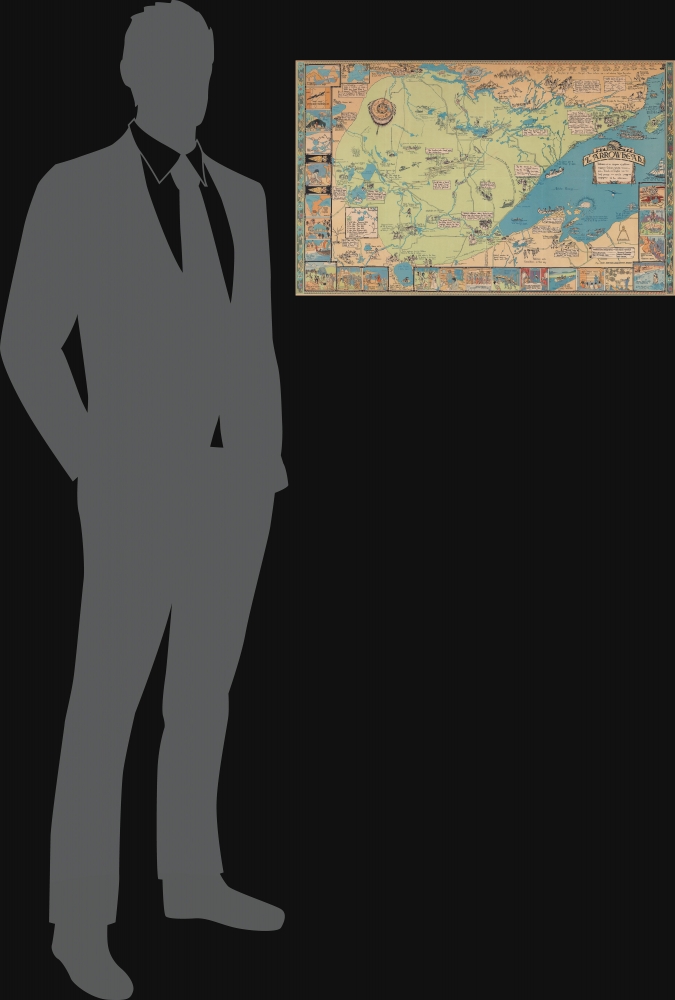1929 Anderson and Arnquist Pictorial Map of Arrowhead Region, Minnesota
Arrowhead-andersonarnquist-1929
Title
1929 (dated) 21 x 34 in (53.34 x 86.36 cm) 1 : 290000
Description
A Closer Look
Coverage embraces from Bemidji and Lake Julia to Isle Royale and Thunder Point and from Rainy Lake to Lake Duade and Izatys ,with vignettes and captions introducing regional history and folklore. The region's Native American and frontier history are at the forefront, with the legend of Paul Bunyan and Babe the Blue Ox appearing as the only easily identifiable folk tale. In one vignette Babe 'runs away' and creates Minnesota's 10,000 lakes with his hoofprints. Boxes line the left side and bottom of the map, along with part of the right side. These hold scenes of historic moments, including interactions with Native Americans and early explorers.The Arrowhead Region, Minnesota
The Arrowhead is the northeastern part of Minnesota near Lake Superior. In includes Carlton, Cook, Lake, and Saint Louis counties. The region acquired its nickname, 'Arrowhead' sometime in the 1920s. The earliest known use of the name was on a 1925 map of Northeastern Minnesota published by the A and E Supply Company of Duluth. The term and iconography were later incorporated into a medal issued for the American Legion's 9th Annual Convention in Minnesota. The third mention, as far as we can tell, is the present map.Publication History and Census
This map was drawn by Irene Anderson, with the blocks and border composed by Kathryn Arnquist. It is based on research compiled by Dorothy Hurlbert and Irma Walker. The work was published by the Hibbing, Minnesota Branch of the American Association of University Women. We note five examples cataloged in OCLC: American Antiquarian Society, the Cleveland Public Library, the Wisconsin Historical Society, the Minnesota Historical Society, and the University of Minnesota Twin Cities. We note only a handful of instances when this map has appeared on the private market.CartographerS
Irene Anderson (1892 - 19xx) was an American public school teacher. Born in Wisconsin, Anderson was a public school teacher in Minnesota by 1910. In 1929, she was an art teacher in the high school in Hibbing, Minnesota, when she designed a map of The Arrowhead region of Minnesota for the Hibbing branch of the American Association of University Women with a fellow Hibbing art teacher Kathryn Arnquist. More by this mapmaker...
Katherine (Kathryn) Arnquist (January 26, 1904 - August 4, 2001) was an American public school teacher. Born in Wisconsin, Arnquist graduated from the University of Wisconsin Madison in 1926 and taught art at Hibbing High School in Hibbing, Minnesota. In 1929 Arnquist helped create a pictorial map of The Arrowhead region of Minnesota. She married Dr. Charles Bane, becoming Katherine Arnquist Bane, and the couple moved to Duluth. Then they moved to Virginia, Minnesota, where Dr. Bane taught philosophy and psychology at Virginia Junior College. Her husband died in 1963 and afterward she split her time between St. Paul and Birch Point on Lake Vermilion. Learn More...
Dorothy Hurlbert (1884 - 19xx) was an American librarian. Born in Illinois, Hurlbert worked as the librarian of the Hibbing (Minnesota) public library from 1915 until 1933. She was part of the research committee that created the 1929 pictorial map of the Arrowhead region of Minnesota. Hurlbert is credited with creating what might be the United States' first bookmobile. In 1919, she loaded 1,200 books on a 2-ton, 35-horsepower truck chassis and served the book hungry community of Iron Range miners and loggers, traveling over 160 square miles. She delivered over 50,000 volumes that first year, and within the next decade Hurlbert had developed relationships with sixteen mining locations, ten rural communities, and eleven schools. Apparently, in 1928, Hurlbert resigned as librarian, but was quickly reinstated, an affair the Minneapolis Star referred to as a 'heated controversy' which swirled around unsubstantiated allegations that Hurlbert was 'uncooperative'. Per the 1930 census, Hurlbert was living with a partner Irma Walker (who also happened to be the chief researcher of the Arrowhead pictorial map). Learn More...
Irma M. Walker (1885 - 19xx) was an American librarian. Born in Wisconsin, Walker graduated from Beloit College in Beloit, Wisconsin, and the library program at the University of Wisconsin Madison. Walker worked as a teacher before she got her first job as a reference librarian in Long Beach, California. Then she became the reference librarian in Hibbing, Minnesota, a position she held from at least 1920 until she resigned in August 1937. Walker was the researcher who compiled the information for the 1929 pictorial map of the Arrowhead region of Minnesota published by the American Association of University Women. In 1930 she was living with Dorothy Hurlbert, another librarian at the Hibbing Public Library. By 1940 she was working as a librarian in Grand Forks, North Dakota. Learn More...
The American Association of University Women (AAUW) (1881 - present) is an American non-profit organization that advocates for equality for women and girls through advocacy, education, and research. Founded in 1881 in Boston by Marion Talbot and Ellen Swallow Richards, that AAUW now has over 170,000 members and supporters, 1,000 branches, and 800 college and university partners. Originally known as the Association of Collegiate Alumnae, the AAUW has participated in many campaigns advocating for women. In 1887, a fellowship was created to support women's education. The organization donated money to the campaign to purchase a gram of radium for Marie Curie in 1919. During World War II, the AAUW worked to support displaced female scholars and began raising money on their behalf. Today, the AAUW sponsors many different programs and still supports women's education through scholarships, grants, fellowships, and other awards. They also support research, STEM education, and leadership initiatives. Learn More...




